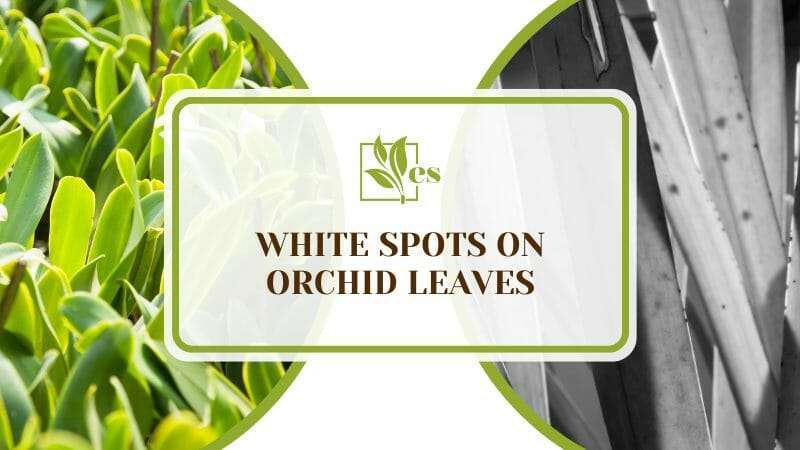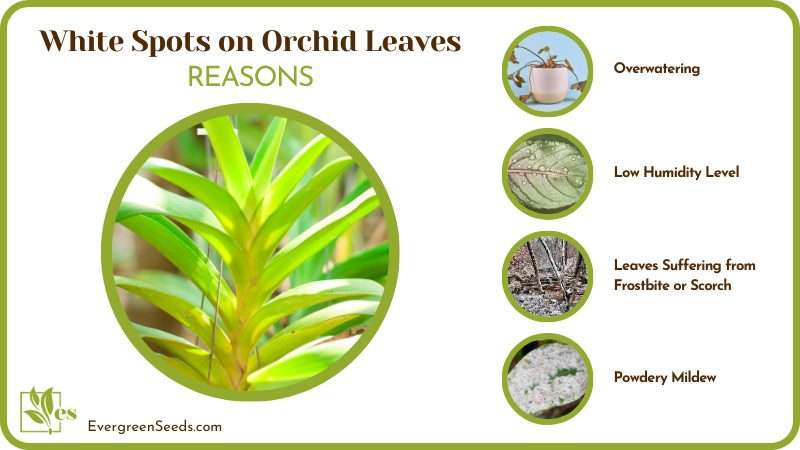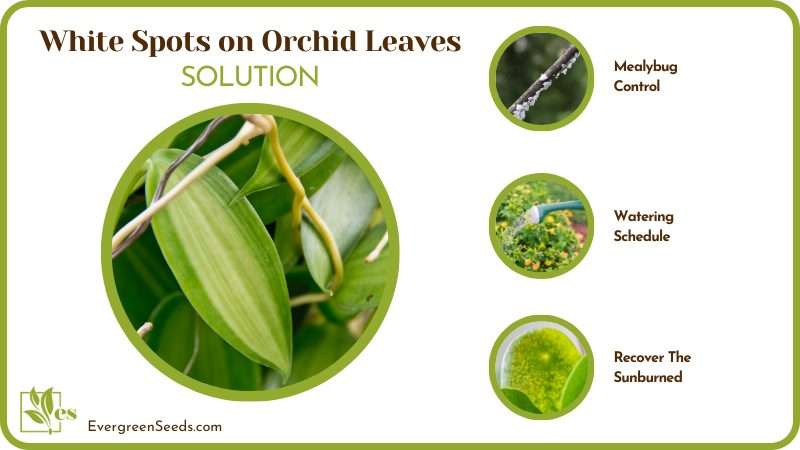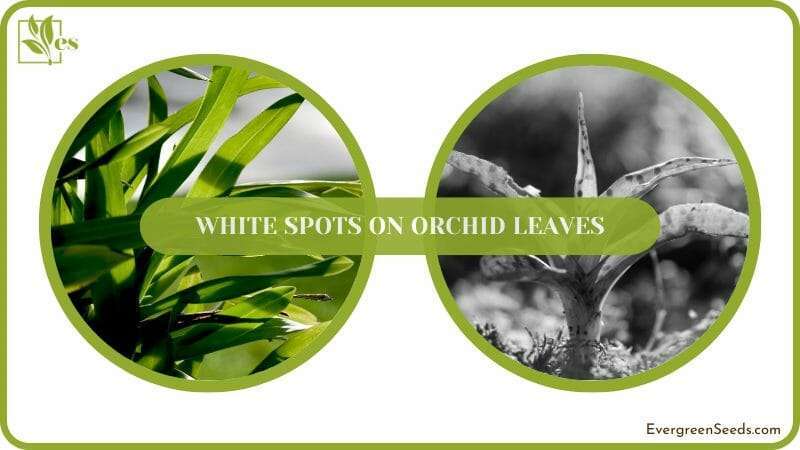White spots on orchid leaves create a panicking situation for many gardeners. These spots can become ordinary if common issues like overwatering, powdery mildew, and mealybug infestations are not taken care of correctly.

Keep reading this article to know how to completely tackle this concern.
JUMP TO TOPIC
Why Are Your Orchid Leaves Getting White Spots?
Having white spots on your orchid leaves would be due to overwatering the plant more than necessary, inadequate humidity, frostbite. In addition, because of fungal diseases such as powdery mildew, and pest infestations such as mealybugs may be the reason.
– Overwatering
An orchid with white leaves is most probably due to an epiphyte that has been overwatered. You need to watch the rate of the irrigation water.
Also, keep in mind that high rigidity and concentration of toxic pollutants create a toxic group, and it would show white spots on them. This, in turn, hurts the root and runs into the stem, killing everything in its course.
As far as watering is involved, the most essential rule is to let the plants dry out between watering and to water them entirely when required. Long-term exposure to dampness can force oval white spots on the leaf with a crack in the center. Also, remember to avoid dipping the ends of the lower leaves. The next stage can be your orchid’s stems starting to get brown.
– Low Humidity Level
When there is no possibility of overwatering, how can an orchid have white leaves? As a consequence of low humidity and short watering, the orchid is in danger of drying out. You will see tiny white spots on the leaves.
Therefore, you can observe the appearance of white spots with white surroundings. Even if the problem is eventually fixed, the orchid will not be capable of recovering its one-time aesthetically attractive appearance.
– Leaves Suffering from Frostbite or Scorch
Burns can also appear as a consequence of being exposed directly to the sun, whether they are frostbite or scorches. In the spring and summer, ultraviolet rays are extremely damaging to your orchid leaves.

The droplets of water on the leaves act as magnifying mirrors, thus, increasing the intensity of the sun’s rays. This may lead to the leaf plates developing dry white spots along with dark surroundings. Also, your orchid’s buds might stay closed during that period.
Besides this, another equally dangerous factor is the frosty winds. The exposure of your orchid leaves to cold air during transport or a brief window space can lead to it developing large white spots on orchid leaves or even yellow spots.
– Powdery Mildew
If you notice white spots on your orchid leaves, there is a high probability that your plant may have been contaminated with a fungal disease known as powdery mildew. An array of tiny spots occur at first and then reproduce, turn white and gray, and eventually begin to dry out. Finally, they die after a couple of days.
Several factors contribute to the development of fungus on the plant leaves. The most common of these is inappropriate watering, followed by extreme climatic changes. Insufficient lighting is also a cause of the growth of this fungal disease, and these would be visually apparent.
If you leave this disease untreated, it will eventually lead to further severe problems, like causing the leaves of your orchid plants to turn yellow, after which they can even die and fall off. These may also appear as transparent spots on orchid leaves.
– Mealybugs
Mealybugs are tiny and slow insects that are notorious for infesting young orchid leaves. Their long bodies are coated in cotton-like white wax. In the case that these insects have infested your leaves, there is a good chance of you seeing white spots on them.
These bugs stick in colonies at the back of the leaf surface and appear as white clumpy sediment. The infestation of these bugs can lead to the stunted growth of your plant and eventual death too.
How To Fix White Spots On Orchid Leaves?
If the reason for the emergence of leaf spots on your common orchid leaves is inappropriate maintenance, changing the conditions of maintenance will swiftly bring your plant back to a fit build. However, if this is not done in time, bacteria, fungi, and viruses can kill the plant too.
– Mealybug Control
Wash any visual mealybugs from your orchid with a cotton swab or a couple of forceps and alcohol to kill mealybugs. However, this method doesn’t completely eradicate the insect population, rather just reduces it.
You can also brush the leaves with gushing water and flush the plant under warm running water. If the plant is severely infested, you need to isolate the Orchid plant from other plants, examine all the neighboring plants, and try to figure out where the infection is coming from. A more extreme option is to trim off the harmed branches and leaves for dealing with an infestation.
– Watering Schedule
It is better to keep to a normal watering program by relying on the season and development stage. A helpful note is to pot your plant in a container with drainage holes in it so that the excess water can easily get eliminated.
This will also help to keep the soil light and dry. You can insert your finger into the soil to test the moisture. If it is dry about an inch below the surface, it is time to water your plant.
Pull the plant from its pot with care and release the seeds from the soil, and then you must check the flower and pull any decaying or damaged areas. In addition, you can even use charcoal powder to minister the injuries and permit drying on its own. Plant in a fresh pot with fresh soil.
– Recover The Sunburned
Since the white spots on the leaves may be from the sunburn, you can bring out the orchid and put it in the middle of the room by surrounding it with fine paper, blinds, or curtains. However, you must make sure that the leaflet is not very hot while grabbing it.
It is also observed that the flower flourishes when kept on a window sill, receiving a steady ray of diffused light.
This is all because as soon as the orchid’s leaves start to leave some white spots because of the sun, it’s time to shift it to a darker or a place with some more shades and change the watering of the substrate.
When it is recovering, do not fertilize your orchid until it has fully healed from its earlier wounds. If the site is in the middle, stay until the leaf is fully dry before releasing it.

– Treating For an Over-Dried Orchid
Sometimes, it is very common for a simple problem like dehydration to cause major issues. You must get your orchid back to its normal watering plan to stop the wilting procedure. There are different reasons for this situation, including increased temperatures, unfitting lighting for a lengthy period, and excess moisture on the leaves.
During the summer, you should water it about two to even three times per week, and this is simply because you will need to increase the frequency of the watering if it’s a hot summer.. On the other hand, in the winter, for no more than one to two-times every week.
– Powdery Mildew Treatment
If the leaves of the orchid create white spots corresponding to powdery mildew, it is advised to quarantine the damaged shrub from the other plants in your garden. This will stop this disease from further spreading in your garden.
Using a cotton pad drenched in a laundry soap solution, wash the white spots on the leaf plates and remove the destroyed parts of the plant. Use cinnamon or base charcoal for the damage.
An alternative solution is to take one tablespoon of dishwashing liquid and two cups of water and make it into a treatment solution. Spray this solution on your orchid leaves to relieve them from all the mealybugs and granular mildew.
Besides this, there are several other treatments you can use for dealing with powdery mildew. Some of these include rinsing your leaves using a soapy solution, scrubbing away any water spots, and also applying suitable pesticides and fungicides.
– Home Remedies to Deal With Pest Attack
Some home remedies may also help prevent infections in your orchid leaves. One of these remedies includes baking soda, as you could get rid of them with a solution that is not a heavy chemical.
Prepare a treatment solution by adding four teaspoons of baking soda and two teaspoons of insecticidal soap to a gallon of water. Spray your entire plant using this solution. Be sure to cover every surface, including the underside of the leaves. Repeat this treatment every two weeks as a preventative or when trying to kill a present infection.
Besides this, cinnamon is another popular home remedy that many people use. This pleasant-smelling spice acts as a natural fungicide and is great for helping prevent infections in orchids.
After cutting the roots, stems, or leaves of your plant, you can apply some of the spice to the affected areas. Make sure to moisten the areas so that the cinnamon is able to stick.
– Providing Good Ventilation
You can also prevent the occurrence of the white spots or the powdery mildew in your leaves by placing your plant somewhere with good air circulation. The orchid fungus thrives in damp conditions.
An important aspect would be, creating a ventilated environment will reduce the chances of it appearing on the plant. Nonteheless, you can allow good airflow by opening up a window or setting up fans where your orchid plant is located.
– Time-to-Time Inspections for Pests
Just like many other plants, pests are a persistent issue for Orchid leaves. Therefore, it is necessary to stay cautious. As soon as you feel that your plant has pests, you should take the necessary measures to eradicate them.
Also, make sure to isolate any new plants for a certain time so that they do not bring diseases to your orchid plant. In addition, you can even cure your orchid from white fungus by sprinkling cinnamon around and on the plant.
– Pruning
If your plant has been contaminated heavily, then it is finer to cut or prune away off all the contaminated foliage, fruits, and stems. It is also the finest choice to toss away all damaged parts and keep them as far away from the actual plant.

Observance with these easy prerequisites will let you grow a beautiful, sensational plant at home. It is only important to pay attention to the complexities of crop maintenance and take the required steps in time.
Final Note:
Soapy water may not effectively remove white spots on orchid leaves. Consult an expert to identify the cause and explore appropriate treatment options.
It is more useful to consistently focus on containing the cause rather than attempting to control it. Having proper orchid care will permit you to detect problems before they become severe.









